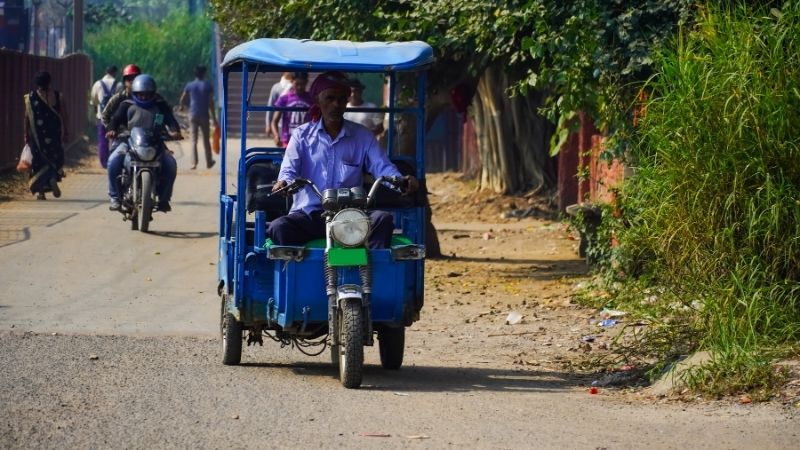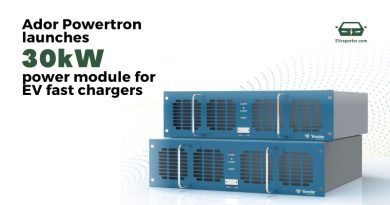Enabling lead acid to lithium-ion battery transition for e-rickshaw drivers
A significant number of e-rickshaws in India rely on lead-acid batteries due to their cost-effectiveness in comparison to Lithium-ion batteries. New industry solutions are emerging that aim to make it easier for drivers to opt for Lithium-ion batteries. In a previous article, we highlighted a business model where lead acid rickshaw drivers opted to retrofit their vehicles to enable swapping instead of buying a new battery at the end of battery life.

Gurugram-based Pointo offers an alternative model, where drivers can lease Lithium-ion batteries for a monthly rental and use it as a fixed battery for their EV. We invited Gaurav Jindal, Co-founder of Pointo, to explain the business they are building and how the model works.
E-rickshaws are at the forefront of India’s EV industry. With a staggering fleet of 2.5 million vehicles and an annual addition of 0.4 million, they have played a pivotal role in driving the shift towards electric mobility. However, the majority of e-rickshaws in the country are purchased with lead-acid batteries as those are significantly cheaper. The additional financial burden of a Li-ion battery is often insurmountable for E-rickshaw drivers who already struggle to pay monthly instalments (EMIs) of INR 8,000 against their monthly income of INR 20,000.
However, there’s a window of opportunity here: lead acid batteries used in E-rickshaws typically need replacement annually. When evaluating the journey of rickshaw ownership over a six-year period (the typical time frame for E-rickshaw operations), the possibility becomes evident.
At the point of lead-acid battery replacement, it becomes a more viable option to use a lithium-ion pack once the vehicle EMI is paid off in the first 2 years. In the case of a lead-acid battery vehicle – The driver needs to replace the lead-acid battery every year for INR 30,000 (A total of INR 1.2 Lakhs for 4 Years).
In contrast, the cost of a lithium-ion battery, while higher upfront (INR 90,000), presents a more economical choice over the long term.
Battery-as-a-Service model and swapping
To address the challenge of lead acid battery replacements, Indian entrepreneurs introduced the Battery-as-a-Service (BaaS) model, offering battery swapping services. Prominent names in this sector, such as Battery Smart, Sun Mobility, Moving, and Charge Up, have entered the market.
However, we feel that the BaaS model is not without its challenges. While it provides flexibility and cost savings, it necessitates frequent station visits, waiting times, and lead to higher battery degradation. During our market research, some drivers reported waiting up to 40-50 minutes during peak hours.
Not all e-rickshaws need swapping
A closer look at the needs of E-rickshaw drivers revealed that not all of them require battery swapping. With higher-capacity batteries (100+ Ampere) available, E-rickshaws can comfortably cover daily distances of 110 kilometres. This is significantly more compared to the average daily run requirement of 70-80 kilometres, eliminating the need for swapping.
The concept of battery swapping originally began with two-wheelers, which faced space constraints necessitating frequent battery changes. In contrast, E-rickshaws have ample boot space, making it possible to install larger batteries that can power their daily operations without the need for swaps.
Business model adopted by Pointo
We provide battery leasing with a fixed 100+ Ampere battery for the e-rickshaw on a monthly payment plan. This approach eliminates the need for middlemen, reducing costs by 40% for end customers.
We feel a crucial point of our model is that it requires no change in customer behaviour and leads to easy adaptability. Drivers still charge their vehicles themselves as they have been traditionally doing with lead-acid batteries. But instead of charging the vehicle for 8 hours, now they do it in 3 hours. Drivers also benefit from an increase in vehicle range and efficiency.
Here’s a breakdown of how this business model operates:
- Battery Procurement – We partner with Non-Banking Financial Companies (NBFCs) to acquire high-capacity lithium-ion batteries from Battery Original Equipment Manufacturers (OEMs).
- Battery Leasing to End Customers – We offer lithium-ion batteries on a leasing basis to our primary customer base, which consists mainly of E-rickshaw drivers. The leasing arrangement is for 36 months and involves a fixed monthly rental fee of INR 3,600 for each battery. This allows E-rickshaw drivers to access better batteries without the substantial upfront cost.
- Profit Margin – We generate revenue by charging end customers a leasing fee. The company maintains a profit margin of around 20-30% on the monthly rental fees. As the business scales and the cost of capital and battery prices decrease, this margin is expected to improve. We are on track to become Profit and Loss (P&L) positive in the coming year.
Additionally, we are in the process of tying up with players in the charging infrastructure space and local garages (50+ onboarded) to provide a charging network and transaction ease through our mobile app. To reduce downtime, we are partnering with vehicle service players that can provide both e-rickshaw and battery repairs.
Future outlook
We aim to deploy 3,000 batteries and extend our services to 12 different cities, intending to reach a broader customer base and take advantage of economies of scale. With advancements in battery technology and projected price reductions of 50% over the next six years, battery financing is set to become an increasingly viable and sustainable model. This empowers customers to own their batteries, aligning with traditional Indian ownership practices. As the industry shifts from a BaaS swapping model to battery financing, we believe battery financing promises both cost savings and convenience for drivers, contributing to the continued growth of the Indian EV market.
Also Read: Battery swapping- The new ‘gig’ in town, which is here to stay
Subscribe today for free and stay on top of latest developments in EV domain.







Pingback: Enabling lead acid to lithium-ion battery transition for e-rickshaw drivers • EVreporter – Automobile India News
Pingback: Mufin Green acquires 20% stake in Li-ion battery leasing player UrjaMobility • EVreporter